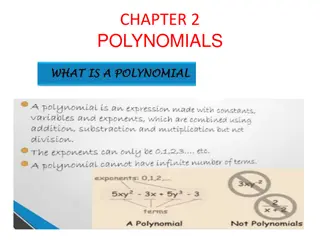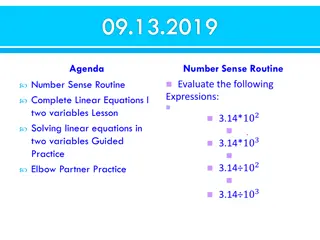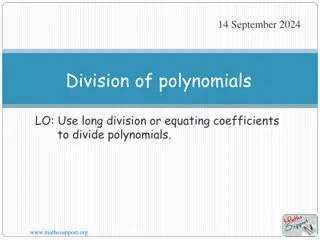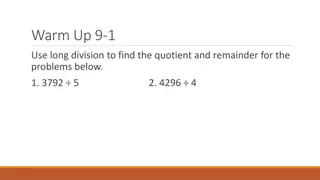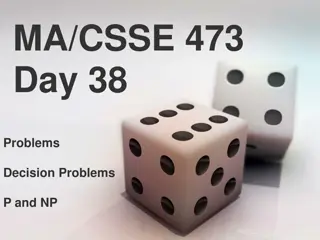Polynomial Equations: Types, Functions, and Solutions
Learn about polynomial equations, their types including monomial, binomial, trinomial, linear, quadratic, and cubic equations. Understand polynomial functions, how to solve them, and graphing techniques. Explore the theory of equations involving variables, exponents, and coefficients.
Download Presentation

Please find below an Image/Link to download the presentation.
The content on the website is provided AS IS for your information and personal use only. It may not be sold, licensed, or shared on other websites without obtaining consent from the author.If you encounter any issues during the download, it is possible that the publisher has removed the file from their server.
You are allowed to download the files provided on this website for personal or commercial use, subject to the condition that they are used lawfully. All files are the property of their respective owners.
The content on the website is provided AS IS for your information and personal use only. It may not be sold, licensed, or shared on other websites without obtaining consent from the author.
E N D
Presentation Transcript
POLYNOMIALS THEORY OF EQUATIONS
POLYNOMIAL EQUATIONS The equations formed with variables, exponents and coefficients are called as polynomial equations. It can have different exponents, where the higher one is called the degree of the equation. We can solve polynomials by factoring them in terms of degree and variables present in the equation. A polynomial function is an expression which consists of a single independent variable, where the variable can occur in the equation more than one time with different degree of the exponent. Students will also learn here how to solve these polynomial functions. The graph of a polynomial function can also be drawn using turning points, intercepts, end behaviour and the Intermediate Value Theorem.
Example of polynomial function: f(x) = 3x2+ 5x + 19 Polynomial Equations Formula Usually, the polynomial equation is expressed in the form of an(xn). Here a is the coefficient, x is the variable and n is the exponent. As we have already discussed in the introduction part, the value of exponent should always be a positive integer. If we expand the polynomial equation we get; F(x) = anxn+ an-1xn-1+ an-2xn-2+ .. + a1x +a0= 0 This is the general expression and it can also be expressed as; F(x) = Example of a polynomial equation is: 2x2+ 3x + 1 = 0, where 2x2+ 3x + 1 is basically a polynomial expression which has been set equal to zero, to form a polynomial equation.
TYPES OF POLYNOMIALS Types of Polynomial Equation A polynomial equation is basically of four types; Monomial Equations Binomial Equations Trinomial or Cubic Equations Linear Polynomial Equations Quadratic Polynomial Equations Cubic Polynomial Equation
Monomial Equation: An equation which has only one variable term is called a Monomial equation. This is also called a linear equation. It can be expressed in the algebraic form of; ax + b = 0 For Example: 4x + 1 = 0 5y = 2 8z 3 = 0
Binomial Equations: An equation which has only two variable terms and is followed by one variable term is called a Binomial equation. This is also in the form of the quadratic equation. It can be expressed in the algebraic form of; ax2+ bx + c = 0 For Example: 2x2+ 5x + 20 = 0 3x2 4x + 12 = 0
Trinomial Equations: An equation which has only three variable terms and is followed by two variable and one variable term is called a Trinomial equation. This is also called a cubic equation. In other words, a polynomial equation which has a degree of three is called a cubic polynomial equation or trinomial polynomial equation. Since the power of the variable is the maximum up to 3, therefore, we get three values for a variable, say x. It is expressed as; a0x3+ a1x2+ a2x + a3= 0, a 0 or ax3+ bx2+ cx + d = 0 For Example: 3x3+ 12x2 8x 10 = 0 9x3+ 5x2 4x 2 = 0
Quadratic Polynomial Equation A polynomial equation which has a degree as two is called a quadratic equation. The expression for the quadratic equation is: ax2+ bx + c = 0 ; a 0 Here, a,b, and c are real numbers. The roots of quadratic equations will be two values for the variable x.
When we have two functions, f(x) and g(x), whereby f(x) = g(x) for all real values for x, we can say that f(x) and g(x) are equivalent functions. Likewise, in polynomials, when we have two polynomials, P(x) and Q(x), where by P(x) = Q(x) for all real values of x, we can say that P(x) and Q(x) are equivalent polynomials. For example, let P(x) = (x+1)2 and Q(x) = x2 + 2x + 1. When we substitute any real value of x into both P(x) and Q(x), their values are always the same. x -2 -1 0 1 2 3 P(x) 1 0 1 4 9 16 Q(x) 1 0 1 4 9 16
PRODUCT OF TWO POLYNOMIALS Multiplying polynomials is a basic concept in algebra. Multiplication of two polynomials will include the product of coefficients to coefficients and variables to variables. We can easily multiply polynomials using rules and following some simple steps. Let us learn more about multiplying polynomials with examples in this article. Rules for Multiplying Polynomials Multiplying polynomials require only three steps. First, multiply each term in one polynomial by each term in the other polynomial using the distributive law. Add the powers of the same variables using the exponent rule. Then, simplify the resulting polynomial by adding or subtracting the like terms.
Multiplying Polynomials Using Exponent Law If the variable is the same but has different exponents of the given polynomials, then we need to use the exponent law. Example: Multiply 2x2 3x Here, the coefficients and variables are multiplied separately. = (2 3) (x2 x) = 6 x2+1 = 6x3
Multiplying Polynomials having different variables Follow the below-given steps for multiplying polynomials: Step 1: Place the two polynomials in a line. For example, for two polynomials, (6x 3y) and (2x+5y), write as: (6x 3y) (2x+5y) Step 2: Use distributive law and separate the first polynomial. (6x 3y) (2x+5y) = [6x (2x+5y)] [3y (2x+5y)] Step 3: Multiply the monomials from the first polynomial with each term of the second polynomial. [6x (2x+5y)] [3y (2x+5y)] = (12x2+30xy) (6yx+15y2) Step 4: Simplify the resultant polynomial, if possible. (12x2+30xy) (6yx+15y2) = 12x2+24xy 15y2
Degree Multiplying Polynomials For two polynomials equations, P and Q, the degree after multiplication will always be higher than the degree of P or Q. The degree of the resulting polynomial will be the summation of the degree of P and Q. So, Degree (P Q) = Degree(P) + Degree(Q)
REMAINDER THEOREM :- The remainder theorem is a formula that is used to find the remainder when a polynomial is divided by a linear polynomial. When a certain number of things are divided into groups with an equal number of things in each group, the number of leftover things is known as the remainder. It is something that "remains" after division. Let us learn the concept of the remainder theorem. The general formula for remainder theorem is expressed as p(x) = (x-c) q(x) + r(x). Let us consider polynomials to prove the remainder theorem formula.
Proof of Remainder Theorem You know that Dividend = (Divisor Quotient) + Remainder. If r(x) is the constant then, p(x) = (x-c) q(x) + r. Let us put x=c p(c) = (c-c) q(c) + r p(c) = (0) q(c) + r p(c) = r Hence, proved.








